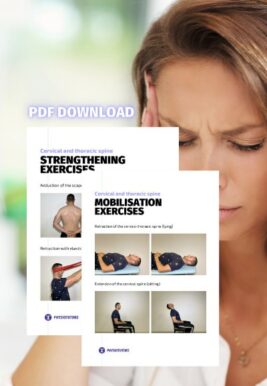Learn
Migraine Headache | Headache & Dizziness Assessment
Headaches can manifest on their own but are also a very common symptom in neck pain patients as more than 60% of patients with a primary neck pain complaint report having concordant episodes of neck pain. Therefore it’s essential to find out what kind of headache the patient is suffering from.
To start off let’s differentiate between primary and secondary types of headaches. But what does this mean? Simply put, primary headaches are a “disease themselves” whereas, in secondary headaches, the headache is a symptom of another condition. So primary headaches would be migraines, tension-type headaches & cluster headaches. Secondary-type headaches are headaches caused by tumors, hemorrhage, other trauma, TMJ dysfunction, substance overdose, or neck pain aka the Cervicogenic headache.
Now let’s take a closer look at migraines, which are primary types of headaches.
Migraines have a mean 1-year prevalence of 11.2% around the world with women being more often affected than men in an age range between 20-50. Migraines exist in two distinct forms: That is either With or without the presence of a phenomenon called Aura. But we will get to that later.
Diagnostic criteria for migraine without aura (A-D need to be fulfilled):
A. At least 5 attacks fulfilling criteria
B. Headache attacks lasting 4-72 hours (untreated or unsuccessfully treated)
C. Headache has at least 2 out of the following 4 characteristics:
- Unilateral location
- Pulsating quality
- Moderate or severe pain intensity
- Aggravation by or causing avoidance of routine physical activity (e.g.walking or climbing stairs)
D. During headache at least one of the following:
- Nausea and/or vomiting
- Photophobia and phonophobia
E. Not better accounted for by another ICHD-3 diagnosis
In order for a headache to be classified as migraine with aura, a patient has to present with the previously mentioned criteria AND one or more reversible Aura symptoms. These are disturbances in the following subsystems:
- Visual
- Sensory
- Speech
- Motor
- Brainstem
- Retina
Imagine vision changes, numbness, dizziness, confusion, etc.
Furthermore, at least 2 of the 4 characteristics have to apply:
- At least one aura symptom spreads gradually over ≥ 5 minutes, and/or two or more symptoms occur in succession
- each individual aura symptom lasts 5-60 minutes
- at least one aura symptom is unilateral
- the aura is accompanied, or followed within 60 minutes, by headache
While the Aura symptoms resemble those of a CVA, they build up much slower. Over 5 minutes compared to within seconds in a CVA.
100% FREE HEADACHE HOME EXERCISE PROGRAM

Tools you can use to assess the impact of a headache on your patient are the HIT-6 questionnaire which you can find in the video description. Also note that it can be difficult for a patient to answer all of the questions on duration, intensity, and characteristics of their headache during your assessment. Therefore asking them to complete a headache diary can help in the assessment and management of the headache and you should be aware that there can be overlap between multiple headache disorders.
If you would like to learn how to diagnose other common forms of headaches, check out the posts below:
The Watson Test is a common provocation test used in the assessment of tension-type headaches and migraines.
References:
Like what you’re learning?
BUY THE FULL PHYSIOTUTORS ASSESSMENT BOOK
- 600+ Pages e-Book
- Interactive Content (Direct Video Demonstration, PubMed articles)
- Statistical Values for all Special Tests from the latest research
- Available in 🇬🇧 🇩🇪 🇫🇷 🇪🇸 🇮🇹 🇵🇹 🇹🇷
- And much more!








